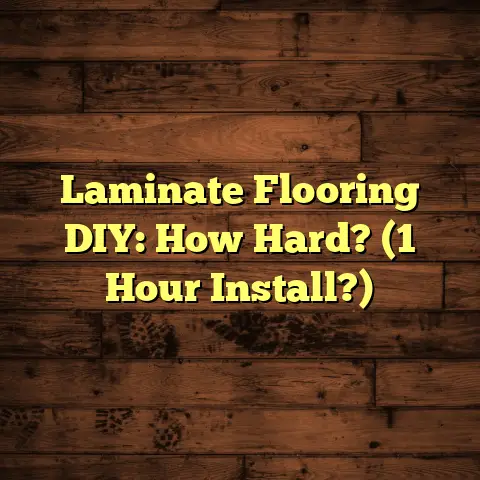DIY Tile Floor Cost? (1 Hour To Find Out!)
I’m going to let you in on a little secret: flooring can make or break a room. It’s the foundation, literally, and it’s one of the first things people notice when they walk into your home.
Think about it – a beautifully tiled floor can instantly elevate your kitchen, bathroom, or entryway from “blah” to “wow!”
And that’s where the magic of DIY comes in.
There’s something incredibly satisfying about tackling home improvement projects yourself. Not only do you save a ton of money on labor costs, but you also get the pride of knowing you built something amazing with your own two hands.
That’s why I wrote this article!
I’m going to give you the lowdown on everything you need to know about the costs associated with installing a tile floor yourself. My goal is to arm you with the knowledge you need to make informed decisions, avoid costly mistakes, and transform your space without breaking the bank.
I’ve designed this guide to be comprehensive yet easy to digest. You should be able to get a solid grasp of the costs involved in about an hour. So, grab a cup of coffee, settle in, and let’s get started!
Section 1: Understanding Tile Flooring
So, what exactly is tile flooring?
Simply put, it’s a durable and versatile surface covering made from materials like ceramic, porcelain, natural stone, or even vinyl.
Each type has its own unique characteristics, benefits, and drawbacks. Let’s break it down:
-
Ceramic Tile: This is your classic, budget-friendly option. It’s made from clay that’s been fired at high temperatures. Ceramic tile is relatively easy to cut and install, making it a popular choice for DIYers. However, it’s not as durable as porcelain and can be prone to chipping or cracking.
-
Porcelain Tile: Think of porcelain as ceramic’s tougher cousin. It’s made from a finer clay and fired at even higher temperatures, resulting in a denser, more durable tile. Porcelain is also less porous than ceramic, making it more resistant to water damage. This makes it an excellent choice for bathrooms, kitchens, and other areas prone to moisture.
-
Natural Stone Tile: If you’re looking to add a touch of luxury and elegance to your home, natural stone is the way to go. Options include granite, marble, slate, and travertine. Natural stone is incredibly durable and adds a unique, organic feel to any space. However, it’s also the most expensive option and requires more maintenance than ceramic or porcelain.
-
Vinyl Tile: Vinyl tile has come a long way! Modern vinyl tile is durable, waterproof, and comes in a wide variety of styles and patterns, including realistic wood and stone looks. It’s also relatively inexpensive and easy to install, making it a great option for budget-conscious DIYers. I’ve seen some great looking vinyl tile and planks that are hard to distinguish from the real thing.
Okay, so now you know the basics.
But what are the overall pros and cons of tile flooring in general? Let’s take a look:
Pros:
-
Durability: Tile is incredibly durable and can withstand heavy foot traffic, spills, and scratches.
-
Maintenance: Tile is easy to clean and maintain. A simple sweep and mop are usually all you need.
-
Aesthetics: Tile comes in a wide variety of colors, styles, and patterns, allowing you to create a truly unique and personalized look.
-
Water Resistance: Most types of tile are water-resistant or waterproof, making them ideal for bathrooms, kitchens, and other areas prone to moisture.
Cons:
-
Comfort: Tile can be cold and hard underfoot, especially in colder climates. Consider adding area rugs or radiant floor heating for added comfort.
-
Installation: While DIY tile installation is possible, it can be time-consuming and requires some skill and patience.
-
Cost: Depending on the type of tile you choose, the initial cost can be higher than other flooring options.
Where does tile flooring work best?
Here are some common applications:
-
Kitchens: Tile is a popular choice for kitchens due to its durability, water resistance, and ease of cleaning. It’s perfect for backsplashes, countertops, and of course, floors.
-
Bathrooms: Tile is a must-have in bathrooms due to its water resistance and ability to withstand moisture. It’s commonly used for floors, walls, and shower surrounds.
-
Entryways: Tile is a great option for entryways because it can withstand heavy foot traffic and is easy to clean. It’s perfect for high-traffic areas where dirt and grime are likely to be tracked in.
Section 2: Initial Cost Considerations
Alright, let’s dive into the nitty-gritty: the cost!
The initial costs of a DIY tile flooring project can be broken down into a few key categories:
-
Cost of Tiles: This is obviously the biggest factor. The price per square foot can vary dramatically depending on the type of tile you choose.
-
Ceramic: Expect to pay anywhere from $1 to $5 per square foot.
-
Porcelain: Porcelain typically ranges from $3 to $10 per square foot.
-
Natural Stone: Natural stone can be quite pricey, ranging from $5 to $50 or more per square foot.
-
Vinyl: Vinyl tile is generally the most affordable option, ranging from $1 to $5 per square foot.
-
-
Underlayment: Underlayment is a layer of material that goes between the subfloor and the tile. It helps to provide a smooth, even surface for the tile, as well as cushioning and sound insulation. The type of underlayment you need will depend on the type of subfloor you have and the type of tile you’re installing.
-
Cement Board: This is a common choice for tile installations, especially in wet areas like bathrooms. Expect to pay around $0.50 to $1 per square foot.
-
Self-Leveling Underlayment: If your subfloor is uneven, you may need to use a self-leveling underlayment. This can add significant cost, ranging from $2 to $5 per square foot.
-
-
Tools and Equipment: To install tile yourself, you’ll need a few essential tools. You may already own some of these, but if not, you’ll need to factor in the cost of renting or purchasing them.
-
Tile Cutter: A tile cutter is essential for cutting tiles to the correct size and shape. You can rent one for around $20 to $50 per day, or purchase one for $50 to $200. I recommend getting a decent one if you plan on doing more tile work in the future.
-
Trowel: A trowel is used to apply the thin-set mortar to the subfloor. You’ll need to choose the right size trowel for the type of tile you’re installing. Trowels typically cost around $10 to $20.
-
Spacers: Tile spacers are used to ensure consistent spacing between tiles. They’re inexpensive, costing around $5 to $10 for a bag of 100.
-
Grout Float: A grout float is used to apply grout to the tile joints. They typically cost around $10 to $20.
-
Other Essentials: You’ll also need other essentials like a measuring tape, level, sponge, buckets, and safety glasses. These items will likely cost you around $20 to $50.
-
Here’s a comparison chart to give you a visual reference:
| Item | Cost per Square Foot (Approximate) | Notes





